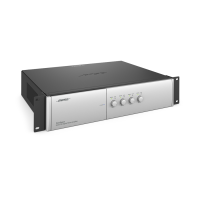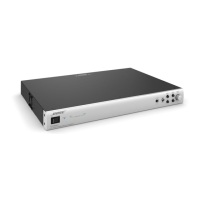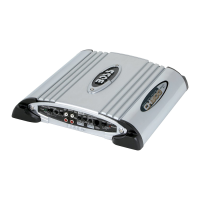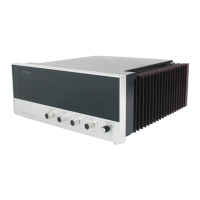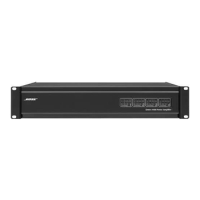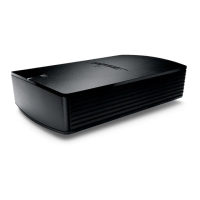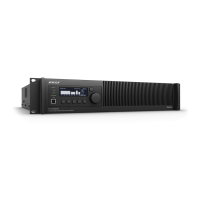58
Input Module (continued)
The signal inputs are designed for balanced connection, though unbalanced inputs can be
configured by proper input wiring. Channel 1 (CH1) line-level inputs are made via P4 [A3] and J4
[A4], Channel 2 (CH2) input connections are made via P1 [A1] and J5 [A2]. P4 and P1 allow for
the insertion of either male XLR or phone plugs. The phone plug terminations are: tip positive (+),
ring negative (-), and sleeve ground. The XLR connections pins 2 and 3 are user configurable. As
shipped, jumper blocks JB2 [B1] and JB1 [B3] have jumpers between pins 2 to 3 and 5 to 6. This
jumper configuration assigns XLR pin 2 to positive (+) and pin 3 to negative (-), pin 1 is ground in
all configurations. If the jumpers are placed across JB1/JB2 pins 1 to 2 and 4 to 5 the XLR pin
assignment becomes pin 2 negative (-), and pin 3 positive (+). The Euro-block terminal block
connectors J4 and J5 assignments are: pin 1 positive (+), pin 2 negative (-), and pin 3 ground.
The CH1 input signal is applied to U1 [E4], and the CH2 signal to U2 [E2]. U1 and U2 are unity
gain (0 dB) differential amplifiers (SSM2141). These inputs are protected against RFI (Radio
Frequency Interference) and ESD (Electro-Static Discharge). The signals are then routed to the
A inputs of op-amp/switch ICs (BA3128) U4 (CH1) [sheet2, B4/5] and U3 (CH2) [B2/3] and to EQ
card connectors J6-4 [H4] and J7-4 [H1] respectively. The switch’s B inputs are driven by the
output of the EQ cards via J6-5 [sheet2, A5] and J7-5 [A2].
The input module detects the presence of EQ cards via J7-6 and J6-6 [sheet1 H5]. Without the
card installed these pins are pulled high (+15V) which keeps both CH1 and CH2 sections of dual
LED D23 [F5] extinguished. This logic high signal is also applied to the control pins of the switch
ICs U3 and U4 which selects the A (unequalized) input. When an EQ is plugged into J7 and/or J6
pin 6 the EQ is detected and pulls the control pin low (+7.5V), turning on the corresponding
LED(s) and switching the IC (U3 or U4) to the B input which selects the output of the EQ card.
On some EQ cards the equalization can be modified for either full range “FULL BANDWIDTH” or
bi-amplified “HF ONLY” operation. The equalization mode switch SW2 [sheet1, G2] selects
either FULL BANDWIDTH or HF ONLY modes of the EQ cards installed. These control signals
are sent to the EQ cards via J6-7, 8 and J7-7, 8.
The selected signals from U4 and U3 are buffered by U7B [sheet2, E5] and U7A [E1] which are
wired to P2 [G1] and P3 [G5]. These phone connectors provide balanced, buffered, equalized
outputs (if an EQ card is installed) to drive additional amplifiers or other equipment. This allows
external equipment to provide equalized signals without the need for additional equalization. The
pin assignment for these connectors is the same as for the input phone connectors P1B and
P4B. The output circuitry is also protected from RFI and EMI.
The amplifier can be operated in three different output modes: NORMAL (two independent
channels) DUAL MONO (one input channel, two separate channels), and BRIDGED MONO (one
input channel drives both output channels, one output channel phase inverted, single load con-
nected between CH1 & CH2 hot outputs). These modes are selected via SW1 [sheet2, G3] and
control the operation of op-amp/switching ICs U6 [E4] and U5 [E2].
When SW1 is set to the NORMAL mode, CH1 and CH2 operate independently. In this mode a
logic high is applied to the control pins of U6 and U5. This routes the outputs of U4 and U3 to
their respective channels in the amplifier via J1-20 and J1-16.
THEORY OF OPERATION

